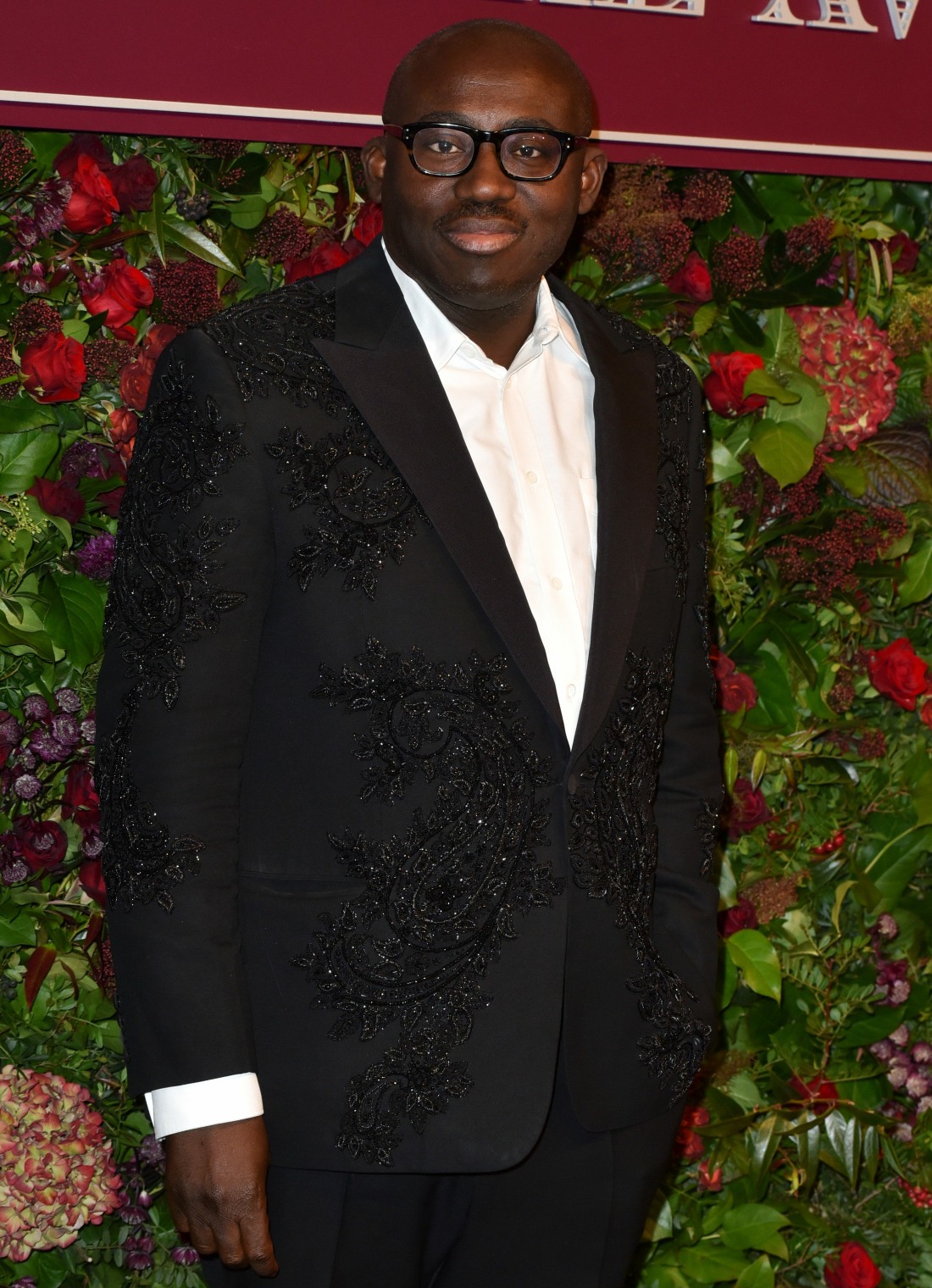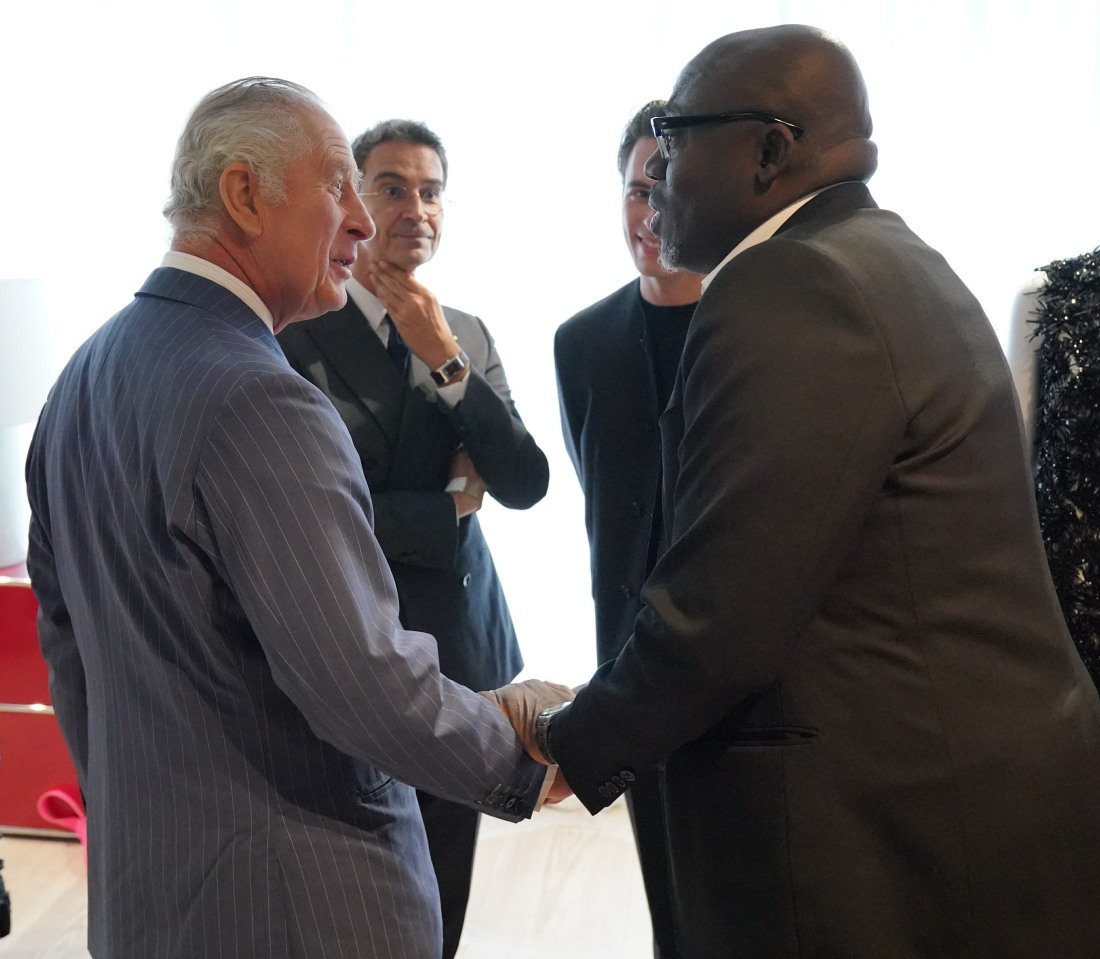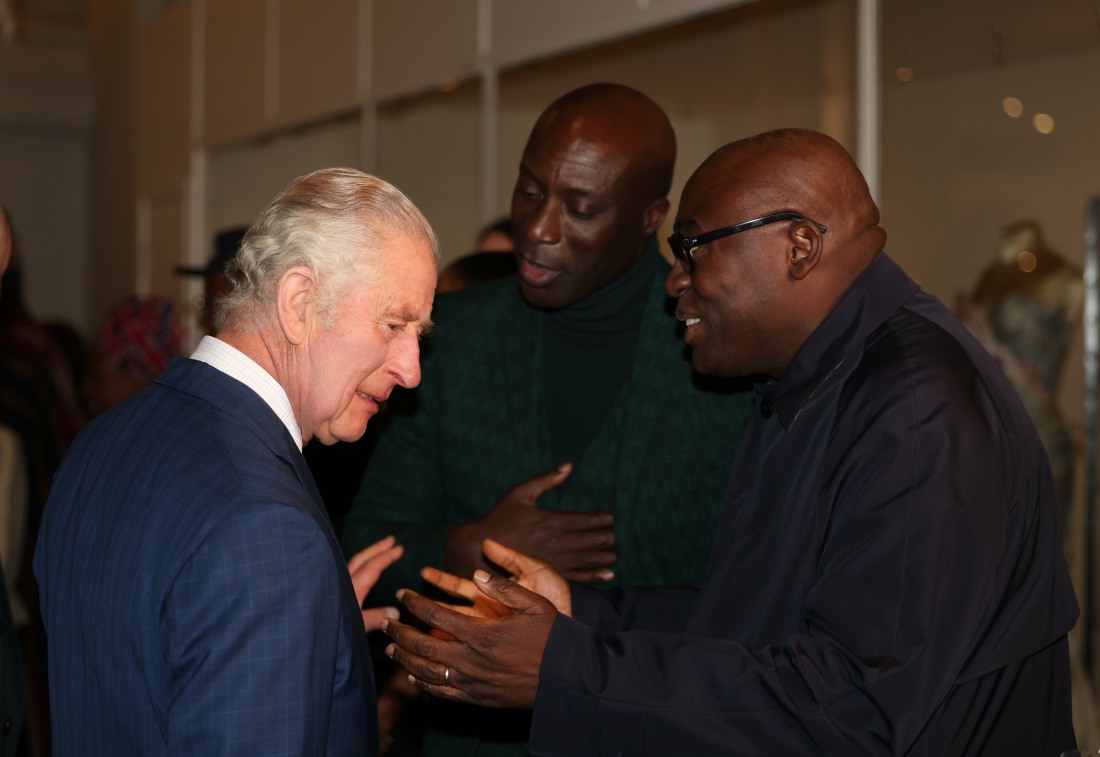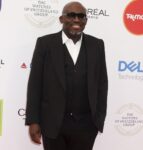There are seemingly many layers to Edward Enninful’s ousting at British Vogue. Enninful handed in his resignation last Friday, saying that he was stepping into a global advisory role for international Vogue editions. Within hours, the rumors began that Enninful had gone up against Anna Wintour and she destroyed him. While I don’t doubt that some version of that actually happened, I also think there was probably a lot more nuance to this entire situation, including the fact that Enninful can and will make a lot more money outside of Conde Nast. The Telegraph had a surprisingly nuanced piece about how a behind-the-scenes ideological battle was part of this Enninful-vs-Wintour issue too. Unfortunately, the piece is called “Why Anna Wintour won Vogue’s war on woke.” The actual analysis is actually spot-on though. Some highlights:
Enninful clashed with Roger Lynch, the CEO of Condé Nast: According to some reports, Enninful’s decision was made at least in part because of a clash of ideas, with Lynch concerned about his progressive politics. At heart, Vogue is just another business, and as recent incidents at Nike, Bud Light, Disney and countless others have shown, the corporate world is an increasingly fraught place where you must strike a balance between selling your product and being seen to hold the “right” views.
Enninful’s progressive politics: As well as immaculate fashion chops (he started out as a stylist), Enninful had a contacts book bulging with famous friends. In the years since, he has cemented a reputation for diversity and activism. He featured the first trans contributor, Paris Lees, and cover star, Laverne Cox. Recent covers have featured disabled subjects. Last September he even featured a man, Timothee Chalamet, alone on the cover.
Advertisers loved Enninful: Advertisers were reportedly keen on Enninful’s new direction, which gave them the chance to be adjacent to a diverse, inclusive range of talent with right-on, social-media friendly messaging. It attracted hundreds of millions of pounds in advertising from companies like BMW. There were positive noises about circulation, too. Condé Nast can be opaque about its numbers, but Enninful’s Forces for Change issue in September 2019, which was guest-edited by the Duchess of Sussex and had Greta Thunberg on the cover, sold out in days.
But British Vogue became joyless: For others, however, Enninful’s activism came at the price of an entertaining magazine. “Everything that made [Enninful] not a classical editor (that is to say, a trained journalist with a ‘words’ background) was why he flew so high early on,” wrote Farrah Storr, former editor of Elle, in a Substack post. “Vogue morphed from a playful, albeit slightly horsey, fashion magazine into a deeply political manifesto.” Along the way, she writes, people stopped buying it: instead it was given away or sold at a discount. “It was joyless, too political and seemed to have forgotten its role as a high-end shopping magazine.”
A larger issue for businesses: “It’s pivotal for businesses to have diversity, not only for the moral sense but the business sense, too” says Octavius Black, the chief executive of consultancy MindGym. Black co-founded his management consultancy with a psychologist, so knows a thing or two about behavioural science. “We know that companies that are inclusive outperform those that are not. But some of these issues can become polarising, as it looks like certain protected categories compete with each other. Women’s rights and trans rights can come into conflict, as we’ve seen in Scotland. The risk is you’re appealing to a niche group and end up reducing your appeal to others. You want to be selling why your products are brilliant, and how you as a company are behaving responsibly and ethically in pursuit of that, but not taking a position on divisive social justice issues. You’d be unwise in America coming out for – or against – abortion, for example, which is not to say that it doesn’t matter, but it’s not the role of a company to take a position on those things.”
Vogue’s readership: Progressive views on gender might help win over celebrities, publicists and advertisers keen to bask in a bit of reflected diversity on social media, but they do not necessarily play as well with the core readership. Vogue readers skew older and female, while readers in the new territories into which Condé Nast is keen to expand: such as the Middle East, India and China, may have more traditional views on social matters. The Enninful approach seems to have been deemed too great a risk.
“You’d be unwise in America coming out for – or against – abortion, for example” – Wintour is a pro-choice Democrat and Vogue has, historically, editorially supported reproductive choice, abortion and birth control. But I get the larger point, which is: Enninful’s tenure at British Vogue was notable for how progressive and inclusive he made the magazine, but it came at the cost of alienating the core readership. Which I agree with, actually – you can argue that Enninful brought new readers, younger readers to the magazine, but if your core readership of middle-aged (white) women are canceling their subscriptions, what is the real cost-benefit analysis? Can you “make up” those lost readers in new readers, readers from a younger generation which doesn’t believe in buying fashion magazines at a newsstand, a younger gen which has already seen the new collections on social media? Is the purpose of British Vogue to give readers what they want or what they need? It’s not a woke-vs-non-woke thing, it’s about the changing landscape of print media.
All that being said, for all of the crying about “wokeism,” Enninful was overwhelmingly a political traditionalist who sucked up to the white establishment in the UK.
Photos courtesy of Avalon Red.
- Dame Anna Wintour poses at the 65th Evening Standard Theatre Awards on Sunday 24 November 2019 at London Coliseum, London. . /LFI/Avalon. All usages must be credited Julie Edwards/LFI/Avalon.,Image: 541023479, License: Rights-managed, Restrictions: WORLD RIGHTS – Fee Payable Upon Reproduction – For queries contact Avalon.red – sales@avalon.red London: +44 (0) 20 7421 6000 Los Angeles: +1 (310) 822 0419 Berlin: +49 (0) 30 76 212 251, Model Release: no, Credit line: Julie Edwards/LFI/Avalon / Avalon (in process) / Avalon
- Edward Enninful attends the 65th Evening Standard Theatre Awards at the London Coliseum, London, England. 24th November 2019. (EDITORIAL USE ONLY – THE PHOTOGRAPHS ARE FOR EDITORIAL USE IN RELATION TO THE STATED EVENT ONLY) -,Image: 541036184, License: Rights-managed, Restrictions: , Model Release: no, Credit line: jw / Bang Showbiz / Avalon
- Anna Wintour at The Fashion Awards, Arrivals, Royal Albert Hall, London, UK,Image: 541094834, License: Rights-managed, Restrictions: WORLD RIGHTS – Fee Payable Upon Reproduction – For queries contact Avalon.red – sales@avalon.red London: +44 (0) 20 7421 6000 Los Angeles: +1 (310) 822 0419 Berlin: +49 (0) 30 76 212 251, Model Release: no, Credit line: James Shaw / Avalon
- THE KING AND THE QUEEN CONSORT VISIT THE AFRICA FASHION EXHIBITION AT THE VICTORIA AND ALBERT MUSEUM The couple met , Edward Kobina Enninful OBE is an English editor-in-chief of British Vogue wearing glasses and Ozwald Boateng, OBE is a British fashion designer,,Image: 735126389, License: Rights-managed, Restrictions: NO UK USE FOR 48 HOURS- Fee Payable Upon reproduction – For queries contact Avalon sales@Avalon.red London +44 20 7421 6000 Los Angeles +1 310 822 0419 Berlin +49 30 76 212 251 Madrid +34 91 533 42 89, Model Release: no, Credit line: Avalon.red / Avalon
- Edward Enninful at The Prince’s Trust Awards 2023 at the Theatre Royal in Drury Lane, London, United Kingdom on 16 May 2023.,Image: 776327309, License: Rights-managed, Restrictions: To licence this image, email info@sidetrack.london for more information., Model Release: no, Credit line: Cat Morley / Avalon
- King Charles III greets Edward Enninful, editor-in-chief of British Vogue, during a special industry showcase event hosted by the British Fashion Council (BFC) at 180 Studios, London. Picture date: Thursday May 18, 2023. Now in its sixth year, the Queen Elizabeth II Award for British Design recognises the role played by British design and fashion in the country’s culture and trade.,Image: 777044251, License: Rights-managed, Restrictions: , Model Release: no, Credit line: Jonathan Brady / Avalon




















I have a question: are there people who actually read Vogue?
I don’t know anyone who does.
Stopped reading most women’s magazines focused on appearance decades ago, because the emphasis is so much on making us feel bad about our bodies so we buy XYZ products (conveniently advertised just a page or two after that article about how men only like women who XYZ).
Yep! I read Vogue and have since childhood, because fashion is a form of artwork, and I follow the artists who create excellent fabric art. I don’t care about the lifestyle espoused, but I care that an artist like Alexander McQueen made outfits that looked as if humans morphed with lizards and aliens and created exoskeletons — some outstanding, creative expression. Fashion is a glorious form of art, and Vogue helped make it financially viable for the artists.
Me too! I think I started my subscription when I was 18 and it’s still running 26 years later. I’ve enjoyed different aspects of it over the years but I agree that the art remains at the centre.
I’m also one of the people who usually goes to whatever fashion retrospective the V&A have on (McQueen was AMAZING), seeing those pieces up close is quite an experience.
I mean, you can easily follow fashion, fabric artists and such even without reading (american) vogue.
New and fresh faces, and especially ones outside of mainstream aren’t primarily (re)presented in Vogue.
Your comment sounds like the only way to follow fahion asan art is Vogue and I really don’t think this is true nowadays.
I sort of do, and I would — if I could find good magazines. I actually like paper magazines and have a few stacks of old favorites— including some old Vogues, French Vogue, Italian Vogue, and some British and Australian magazines, along with some vintage copies of Essence. I used to love Vogue — and found it somewhat aspirational, even when the target audience was clearly white women with bank balances, social calendars, and aesthetics that differed sharply from my own. The last decade or so of American Vogue hasn’t done it for me.
As I said in a previous post, I would love a more adult-targeting version of what Teen Vogue was like when Elaine Welteroth was the editor. I’d invest in a lifetime subscription. (I’m not knocking any other editors, but Welteroth was the editor when I happened to notice the magazines.)
Honestly this is not inaccurate. Back when I still bought print magazines, I bought Vogue to look at the fashion. I never read the articles. That being said, who buys it nowadays? Print press is a shameful waste of paper and I prefer reading articles on my iPad where I can increase the text size for my older eyes! Even my dentist office don’t subscribe to magazines for the waiting room anymore.
I bought fashion mags to get ideas for outfits. I couldn’t afford designer duds so I scoured affordable stores to replicate what I saw. I NEVER read articles. I could go through Vogue in 15 minutes, tearing pages out, and throwing the mag in recycle.
I always read most of the articles. One of the reasons I kept up my subscription to Vogue — when I stopped reading other magazines— was the quality of the articles, combined with aspirational fashion and architecture/living spreads.
Maybe, just maybe, with Covid, an unstable economy, and unstable local and global politics, folks have better plans for their money than buying an expensive magazine to look at $2000 purses they can’t afford to buy.
Maybe. I first got into reading Vogue long ago, as a struggling student. I enjoyed the articles, and enjoyed adapting the few things that I admired from the pages of Vogue to my own growing aesthetic views and very limited budget. It might have been noticing the shape of a purse, Or the color and fit of a sweater. I was lucky enough to have access to sample sales and some very good second hand shops at the time though, so that helped, and the treasure hunt aspect of my shopping made it fun — rather than frustrating.
His fashion is on point. That glitter jacket is something I would wear the hell out of. Also, it’s quite a shock to see Charles standing next to Two Black men at the same time, proving the royal family is NOT racist– they stand next to Black people nanoseconds at a time! I’d bet big money we’ll never see THAT again. Big, big money.
@JFerber I can’t believe that the BRF hasn’t constantly found reasons to put that picture out there!
I actually began reading British Vogue more last year because it was finally “growing up” the discourse that Teen Vogue has taken on for a decade now. Teen Vogue is incredibly progressive and awesome. I’m sad that British Vogue became just another prototype of the American one.
I’m going to wait and see where it goes from here because I have been enjoying the articles more since he came on board and if I do decide to bail Teen Vogue keeps popping up so I may give that a try instead.
The only reason BV is on the map is because it became inclusive and followed Italian Vogue. US Vogue is white and caters to UES nepo babies. As from creativity and innovation, US Vogue ain’t it .Gabriella ‘s Barbie layout was the best in aeons. I flip through it in the checkout line but never fork over $$ to buy.
How unfortunate that he tried his best to cosy up to the white establishment and still got push out. I mean, he shouldn’t be surprise. That’s what it usually is for people of colour succeeding in traditional white spaces so I found it disappointing when he participated in dunking on Meghan. The only vogue magazine issues that I bought was Angelina’s and Meghan’s
I know not everything is about Meghan but I can’t help circling back to this also. I was so disappointed and dismayed with what he said about her. It wasn’t just that it was negative. He criticized her for not understanding the oh-so-important etiquette rules of TRF. Just so ungracious and, now, pretty ironic.
So Vogue is supposed to be a Sears catalog for the rich, now?
It used to be innovative, arty, and risk-taking. Anna killed off Diana Vreeland’s legacy permanently when she sidelined Andre Leon Talley. But some of us remember the original Vogue. Anna ruined it.
Yes, I am an old.
I’m thinking the answer to your question is yes. It’ll be interesting to see how bland it goes from here.
The problem is that older white ladies are as likely to be influenced by the youngins on TikTok who will happily tell us what the trends actually are vs what vogue’s marketing decides to sell us this season. Do people know how long Vogue was trying to break the absolute stranglehold of skinny jeans? Like a decade. Then gen z came along with their cargos and that was it.
Vogue needs to cater to their older audiences since young people don’t buy magazines. It is what it is. Vogue is a business and they don’t want a Budweiser debacle if they start trying to be too woke.
@Bee: I very much agree. Vreeland and Talley, and even Grace Mirabella.
With the exception that you’re old, I agree with everything you said, Bee.
As soon as Anna Wintour got her spindly fingers on American Vogue, it took a hard turn toward the bland.
The once relevant and evocative American Vogue under the leaderships of the iconic Diana Vreeland, and Grace Mirabella, became crustless Wonder Bread under Anna Wintour, IMO.
American Vogue has been that way ever since.
I believe this piece way more than the Times piece that had Edward attempting to take Anne’s job. It never made sense to me that a politically “smart” and traditional person like him would make a power play at Anne Wintour without any kind of buy-in or support. Nevertheless it’s Conde Nast’s loss. He made the magazine fresh and interesting again, oh well!
“slightly horsey”? Is this a British thing or am I just a bit dense… I can’t really guess at the meaning of ” slightly horsey” in this or any context outside of a throat infection.
In the British context it means not living in London, might have horses, but not joining the “horsey” social set. AKA the old school set who have horses, drink a lot, and probably see Camilla as a style icon.
oohhhh. Thanks.
Camilla is exactly what immediately springs to my mind whenever I read the word “horsey”
Sorry, I don’t feel too bad for him. He was so quick to throw Meghan under the bus to suck up to the royals even after Meghan gave him and Vogue their biggest issue for that year. He was quick to say her treatment wasn’t based on racism, I wonder now if wonder if this treatment has something to also do with his race.
I looked up his criticisms of Meghan and was disgusted. Weird that the Vogue editor, after a publication smash, would run to Tom Bower to complain about Meghan–and let his staff do it–in a book, no less, where it’s there forever.
It’s the usual: this black woman doesn’t suck up to people. She isn’t deferential, she goes about things in her own way, she has her own staff. That is scary! They were afraid. Afterward, when the project is a big success, they take credit, implying they succeeded in spite of her ideas and work methods. They offer NO specifics, per usual.
“The staffers thought the contributions were shallow and didn’t make sense, the book said, but did not ask her to explain for fear of confrontation. It did not give specific examples.”
Bower wrote that Enninful and Markle also differed on how to publicize the book. He described a plan by Markle for “lighting up the internet” with leaks, and said Enninful instead favored secrecy.”
“The most heated clash, the book said, came when Markle asked her head of communications, Sara Latham, to get Vogue to change its schedule so that the magazine would publish in the US first and the UK second.
https://www.insider.com/meghan-markle-feuded-british-vogue-editor-enninful-control-book-2022-7
Wow I hadn’t even read those quotes. Efffff him. Byeee and don’t let the door smack ya on the ass.
Also criticizing him of pandering to the white establishment has to be nuanced when you consider the complexity in which dark-skinned black people have to move within white spaces where the racism is much more overt/with lasting consequences. To be a black person in the western world requires a level of pandering to white people and it is exhausting. He would not have made it as high as he did in Vogue without knowing how to do it. The world makes it impossible for us, and so unless you are willing to do a deep dive into his life and completely dissect how he has moved up into the roles he is given the tide of resistance that he would have had to deal with, then I don’t think it’s fair to paint him in that one brush stroke.
This is very true.
So true.
I’m white and I can’t fathom the complexities & nuances of navigating the world as a dark skinned person. But it’s so simplistic to assume that Enninful endorses the BRF just because he was polite to aristocrats in a professional setting. Blame the system that upholds scumbags like Charles instead of the individuals navigating the aftermath of colonialist violence & invasion.
Concern Fae, Of course you’re right about the horsey set, but isn’t there also something about them being genteel and shabby, not having a lot of money, etc.? Of course, I immediately thought of the horse-faced looks of so many of the royal family. Love horses, beautiful creatures, but not horsey looks on the faces of humans–unbearably unattractive!
I haven’t looked at an issue of “Vogue” in years, or any fashion magazine really. I like clothes, especially vintage stuff, but cutting edge and runway fashion is wasted on me. I might be the rare one who actually would read the articles more than I would look at the pictures.
I was curious about one thing in the fifth paragraph, about women’s rights and trans rights coming into conflict, specifically in Scotland. What exactly happened there?
The elephant in the room is ENVY. He is seen as an outsider who dared ” shine”, he must be punished …..And he was……
Sales reflected that reality; the reason he was beloved by advertisers.